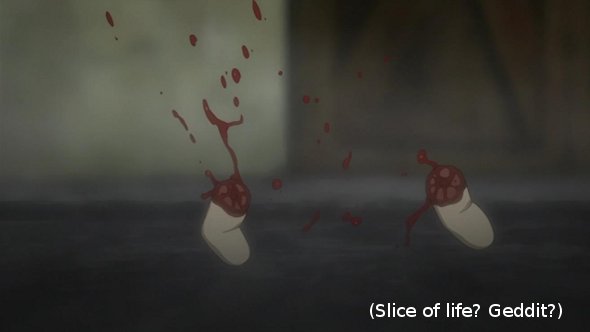Akirascuro recently wrote a post about how to judge slice-of-life shows. The biggest problem I noticed there: he seemingly took slice of life synonymous with moe or healing anime, whereas I would include shows like Bunny Drop or Arakawa Under the Bridge. You may count this as another (futile?) try to pin down the genre.
Let’s start with an intuitive view on what slice-of-life is and look at possible subgenres. I think it’s convenient to divide it into three: SoL-comedy, SoL-drama and healing anime. Definition time!
SoL-comedy: Jokes are told in an everyday setting.
SoL-drama: People have to overcome trials in an everyday setting.
Healing: An idealized depiction of an everyday setting where people (mostly girls) are nice to each other for the heck of it.
I’m sure there are better definitions out there, but I think they are good enough at including the right shows while excluding the wrong ones. You might see problems with them, but I think most of these vanish when you take the genres as not mutually exclusive. You might also want to add more genres like moe, ecchi and absurdist comedy, but I see them as attributes, not genres.
The next question: Are SoL-comedies and SoL-dramas subgenres of comedies and dramas in general? For comedies it’s quite easy to answer this with a yes. For dramas it’s a bit more difficult: a confession is a bit of a different solution to a problem compared to a legendary wizard staff or a new superweapon to blast the villain away. However, the same interpretative strategies can be used for all of them. What the characters want and the obstacle in their way creates a conflict, which has to be solved. Most of the time it’s easy to see a three or five act structure. The inner conflict leads to character development, the outer conflict leads to plot development. Therefore I think it’s reasonable to view these two kinds of SoL-shows as subgenres of their respective more general counterpart.
Healing shows are a completely different beast to slay. Are there jokes? Occasionally, but they’re not frequent enough to be a main characteristic. Is there conflict? Yes, but it’s usually too toned down to be terribly important. What does that leave us with? The characters, the setting and the atmosphere, but that’s shared with every kind of story. The big difference is the lack of anything else. This is not necessarily a bad thing. I certainly wouldn’t hate it if rude people didn’t exist. It’s another form of escapism. The difference is that you escape into a nicer world as opposed to a more exciting world.
So far this post has been rather useless brain exercise. Now what do we get out of it? Preferrably a way how to judge these kind of shows. For SoL-comedies and SoL-dramas that’s quite easy: just do it the same way you judge other comedies and dramas. As before, healing shows are the big problem. Their lack of attributes means there’s a lack of unique ways to evaluate them. There’s only characters, setting and atmosphere and – as sources of those – the writing, the directing and the music. Stuff that all anime has.


